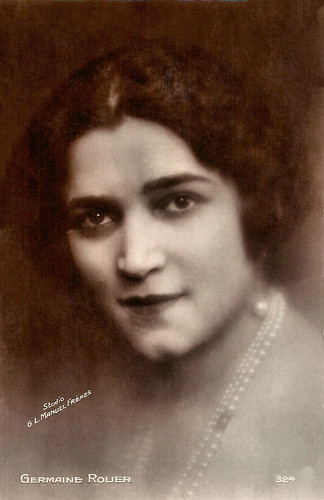
French postcard by Cinémagazine, no. 324. Photo: Studio G.L. Manuel Frères.

French postcard by Edition Cinémagazine, Paris, no. 324. Germaine Rouer in La Cousine Bette/Cousin Bette (Max de Rieux, 1928).
Les Vampires
Germaine Joséphine Rouer was born in Paris in 1897. She attended the Conservatory of Dramatic Art where she graduated in 1919, in comedy and tragedy.
After a short engagement at the Odéon, she worked with the Theatre de Porte Saint Martin and later the Theatre de la Renaissance, touring internationally. Already at age 13, she debuted in the cinema with short silent films like Les deux orphelines/The Two Orphans (Albert Capellani, 1910). As an adult, she played parts in the crime serial Les Vampires/The Vampires (Louis Feuillade, 1916) and in Perdue/Lost (Georges Monca, 1919).
In the early 1920s, Germaine Rouer was the main actress in André Antoine’s naturalist and rural drama La terre/The Earth (1921), based on Émile Zola’s novel. It was one of Rouer’s best roles. In this film, a young unemployed man (René Alexandre) befriends a farmer’s daughter Françoise (Rouer). He gets mixed up in her family feuds when the old grandfather prematurely divides his goods, a la King Lear. Françoise is actually the only positive character in this story.
Other films were the Arthur Conan Doyle adaptation Un drame sous Napoléon/Uncle Bernac (Gérard Bourgeois, 1921), Les deux soldats/The Two Soldiers (Jean Hervé, 1921) with Maurice Escande, Le pauvre village/The poor v illage (Jean Hervé, 1921) shot in Switzerland, and La flamme/The flame (René Hervil, 1925).
Der gute Ruf/The Reputation (Pierre Marodon, 1926) was a Franco-German co-production based on the book by Herman Sudermann and starring Lotte Neumann. She played the title role in La Glu (Henri Fescourt, 1927), and La Cousine Bette/Cousin Bette (Max de Rieux, 1927) after Honoré de Balzac. Her last silent film was Julien Duvivier’s Au bonheur des dames (1930), again a Zola adaptation, where Rouer played the rival at the department store of the main character, played by Dita Parlo.

French postcard by Edition Cinémagazine, Paris, no. 497.
A modern Circe
Germaine Rouer remained foremost a stage actress. In 1933, she was admitted to the Comédie française and was nominated to be an honorary member in 1956. But she also continued to perform in films, and in the early 1930s, she made a smooth passage to the 'talkies'.
She played leading roles in Deux fois vingt ans/Twice Twenty Years (Charles-Félix Tavano, 1931) with Annabella, Roger la Honte/Roger the Menace (Gaston Roudès, 1933), opposite Constant Rémy and France Dhélia, La pocharde/The Drunkard (Jean Kemm, Jean-Louis Bouquet, 1936), and Le chemin de lumière/The light path (Paul Mesnier, 1937).
She played a modern Circe in La femme du bout du monde/The Woman at the End of the World (Jean Epstein, 1937). Then, it took over a decade to see her return to the cinema with smaller parts in Le dolmen tragique/The Tragic Dolmen (Léon Mathot, 1948) and L’enfant des neiges/The Snow Child (Albert Guyat, 1951).
Her last, uncredited part was that of Mademoiselle Molière in Sacha Guitry’s Si Versailles m’était conté…/Affairs in Versailles (1956). In Kevin Brownlow and David Gill's wonderful TV series Cinema Europe: The Other Hollywood (1995), Rouer at the time in her nineties memorises her role in La terre.
Germaine Rouer died in 1994 in her hometown Paris at the age of 97. She was married to film director Pierre Mardodon. Their daughter was the stage actress Thérèse Marney (1927-1968).

French postcard. Photo: Studio Harcourt, Paris.
Sources: Thomas Staedeli (Cyranos), 1895.revues (French), Wikipedia (French) and IMDb.
No comments:
Post a Comment